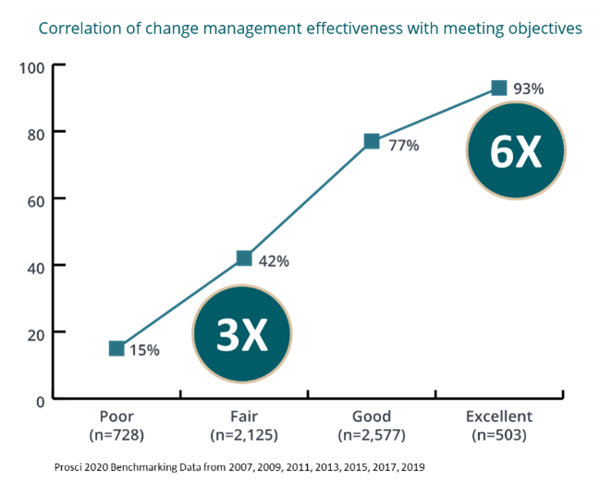
In my role at Prosci, I have the privilege of working with senior executive teams across different sectors and geographies. Even before the pandemic changed the way we work and live, the dialogue had already begun shifting to conversations about extraordinary levels of change in their organizations. There has never been a better time to build enterprise change management capability and benefit from the investment.
EVER-PRESENT, ACCELERATING CHANGE
In the years leading up to the pandemic, organizations were already grappling with accelerating rates and increasing volumes of change. I often heard comments like, “We’ve got more change coming in the next three years than we’ve experienced in the last 20,” and “Our future depends on the success of the transformation efforts.”
Once COVID-19 disrupted our world, such conversations became the norm, except with more urgency. Some organizations are quickly realizing and acting on the need to ramp up their change management efforts. But when I ask some leaders what approach they use to address the people side of their most important changes, I get a variety of reactions – from blank stares to multiple requests to rephrase the question.
The need to establish a robust enterprise change management capability still lives in some leaders’ blind spots.
The high price of low user adoption

We all know that value comes not from what gets built, but from what gets used. Yet I’ve seen multi-million-dollar projects scrapped simply because of a lack of user adoption. And it’s not an isolated issue – it has happened in telecom, healthcare, higher education, utilities, consumer products, travel, insurance, retail, and many other sectors.
At Prosci, we coach clients that these “glorious belly flops” are only real mistakes if they fail to harvest lessons from them. Instead of focusing only on blame, organizations must prioritize adoption and reinforcement. On the bright side, the risks associated with not building organizational change capabilities are fast becoming a C-suite discussion topic.
One of our multi-billion-dollar global clients even shared feedback that their board identified change adoption as a top enterprise risk.
The growing demand for change management
Organizations are forced to pay for change management whether they know it or not. It’s much easier and more prudent to pay a small amount proactively and intentionally than to pay a multiplier later to clean up a mess.
Through numerous failed changes, leaders are starting to view change management not as an optional add-on but as a must-have discipline on the path to value realization. This understanding is a key part of the value of change management
story: adoption doesn’t happen by accident. It takes structure, sponsorship, and investment.
A CFO once put it best:
“We need to start investing at least as much in change management as we are willing to put into contingency budgets.”
Tips for Growing Enterprise Change Management Capability
What does it mean to build a change-capable organization? Here are four proven ways to strengthen your foundation:
1. Secure a dedicated sponsor
Building enterprise change management capability requires a named leader with authority, influence, and courage – not just a nebulous leadership group.
2. Choose the right first projects
Highly visible quick wins create early proof points. Pilots in the first 100 days are more effective than waiting years for transformation results.
3. Engage senior leaders through outcomes
Position change management not as training but as a business accelerator. Executive sponsor briefings embedded in existing meetings work best.
4. Clarify sponsorship roles
Sponsors often underestimate what visible, sustained commitment requires. Awareness, advocacy, and active communication are essential for adoption.

Source: Prosci
The Business Value of Change Management
Research consistently shows a direct correlation between the value of change management and project outcomes. Projects with excellent change management are six times more likely to meet or exceed objectives compared to those with poor adoption practices.
This isn’t just theory. From IT implementations to large-scale cultural transformations, organizations that embed enterprise change management capability into their DNA outperform competitors in speed, adaptability, and resilience. The ROI is clear: greater adoption, faster benefit realization, and stronger long-term sustainability.
Organizational Change Is Here to Stay
Change is no longer episodic. It is constant, disruptive, and accelerating. The ability to out-change the competition is now a differentiator in every industry.
The only way to thrive in this environment is to embed enterprise change management capability into the culture – making it a repeatable skillset, not a one-off response.
Marg’s Perspective: Building Change Capability for India’s Future
At Marg Business Transformation, we see this every day with clients across industries. Leaders who understand the value of change management don’t just invest in single projects – they build scalable enterprise capability.
As the exclusive Prosci Affiliate in India, Marg equips organizations to integrate structured methodologies, practical tools, and leadership training into their DNA. The result? Consistent adoption, measurable outcomes, and a future-ready workforce.
For us, enterprise change management capability is not just a framework; it’s the pathway to sustained transformation. It ensures that AI, digital, or process-led initiatives don’t just launch – they stick, scale, and succeed.
Conclusion
The value of change management lies in its power to convert ideas and investments into real results. Without adoption, even the best-designed projects fail. With a strong enterprise change management capability, organizations can not only deliver today’s initiatives but also prepare for tomorrow’s disruptions.
👉 At Marg, we help organizations unlock this capability through Prosci research, certification, and consulting support. If you’re ready to invest in a future where change is not a risk but a competitive advantage, connect with us today.






